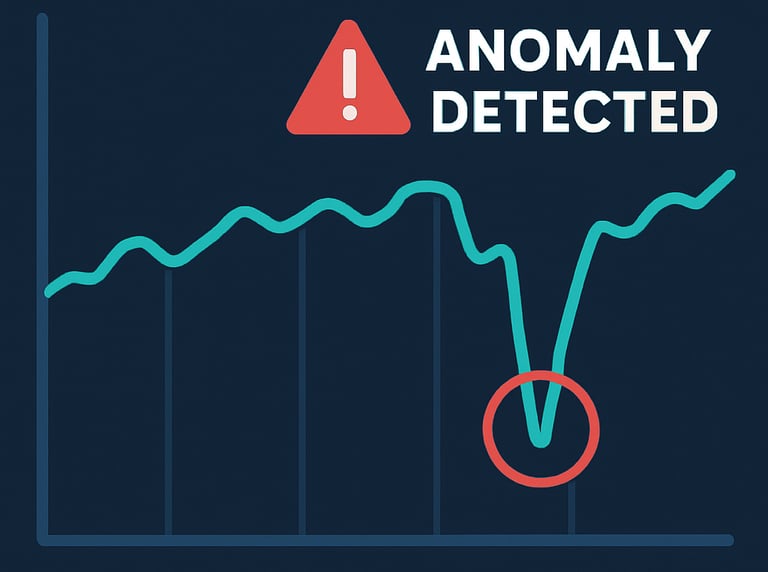Detecting Anomalies with Salesforce Data: Why Traditional Reporting Isn’t Enough—and How Reliably™ Will Help
Salesforce is a powerhouse for storing, updating, and acting on customer data—but when it comes to deep data analysis and anomaly detection, most admins and operations teams quickly hit a wall. Whether you’re trying to detect a silent failure in automation, or uncover a trend that signals a process breakdown, relying on native Salesforce reporting alone can be limiting.
SALESFORCESALESFORCE INTEGRATIONGENERAL INFORMATION
6/9/20253 min read
Understanding how to analyze your Salesforce data across time and logic thresholds is crucial. It’s not just about knowing what’s happening—it’s about knowing what’s different, unexpected, or broken.
Let’s break down four key types of data analysis used to detect anomalies—and how each can unlock powerful insights when applied to your Salesforce data.
1. Persisted + Comparison
This approach relies on a date or date/time field to pull a count of records created or modified during a specific timeframe, and then compares that count to previous periods or a rolling average.
Use Case Example:
Daily total leads created, grouped by lead source.
Compare today’s volume to:
Yesterday
The same weekday last week
A 7-day rolling average
If today’s lead volume from paid ads suddenly drops 60%, you might be dealing with a disconnected integration or an error in lead routing automation.
Insight: This method helps uncover unexpected spikes or dips in activity tied to operational or technical changes.
2. Persisted + Threshold
Also using a date field, this method checks whether a count during a time period is above or below a fixed number—a hard threshold you determine.
Use Case Example:
Daily total leads created by source.
Alert if any lead source has < 20 leads in a day.
This method is useful when you have defined baseline expectations and want to be alerted if activity drops below (or jumps above) a critical threshold.
Insight: Great for guardrail alerting when consistent activity is expected.
3. Real-Time Snapshot + Comparison
This type ignores date fields and instead pulls a real-time count of current records—like inventory—then compares that result to the same query run previously.
Use Case Example:
Monthly total number of open Leads.
Compare this to the rolling average from the past 6 months.
If the number drops 20%, maybe a mass update mistakenly closed records. If it jumps 30%, maybe something is broken in your Lead assignment automation.
Insight: Useful for detecting changes in inventory-like metrics where the expectation is relative stability.
4. Real-Time Snapshot + Threshold
Same snapshot method, but instead of comparing, you define hard thresholds.
Use Case Example:
Total closed Leads in the system.
If the total exceeds 50,000, flag for possible archive or cleanup.
Insight: Ideal for managing record growth, data storage, and archiving strategies.
Why Having These Numbers at Your Fingertips Matters
For Salesforce Administrators and platform owners, anomalies in this data often point to silent failures:
Broken Flows
Disconnected integrations
Missing automation triggers
For business operations managers, the same data might reveal:
Poor agent productivity
Workflow inefficiencies
Misuse or underuse of key Salesforce features
Without monitoring these trends, you’re left blind to process breakdowns until they become costly problems.
Why Salesforce Reports Alone Aren’t Enough
Yes, Salesforce Reports can show you numbers.
But to detect anomalies like those described above, you’d need to:
Build dozens of reports
Export to Excel or a BI tool
Maintain comparison formulas manually
Repeat this weekly or daily
And that’s before you hit native Salesforce limitations:
Snapshot reporting only stores 2,000 rows per run
Limited to 200 scheduled jobs per org (shared by everything)
No built-in way to compare two snapshots or highlight deviation
The result? A lot of manual work or expensive external tools just to answer questions like:
Did something break yesterday?
Are my data volumes trending abnormally?
Is this process slowing down over time?
Reliably™: The Future of Salesforce Data Monitoring
We’re excited to announce Reliably™—a native Salesforce application designed specifically to monitor your data and detect anomalies without the headache.
Reliably™ will:
Run persisted and snapshot queries on your Salesforce data.
Store and compare results across time.
Detect threshold breaches and percentage deviations.
Alert you when something unexpected happens.
Present results with clean dashboards and visual trend tracking.
All of this happens inside Salesforce, with no external systems, code, or spreadsheets.
Whether you’re managing a high-volume Sales org, a complex Service Cloud setup, or critical Flows and automations, Reliably™ helps ensure everything is running as expected.
Join the Waitlist for Early Access
Reliably™ is coming soon to the Salesforce AppExchange—and we’re inviting forward-thinking teams to join the waitlist for early access and exclusive lifetime discounts.
📩 Sign up now at www.getreliably.app to:
Get notified when Reliably™ launches
Preview product features
Claim a founder-level discount for early adopters
Better-run Salesforce orgs start with better visibility. Let Reliably™ do the watching—so you can do the leading.


